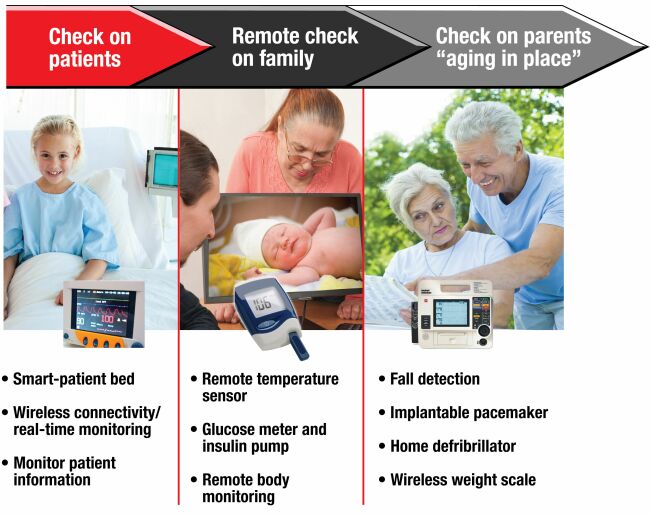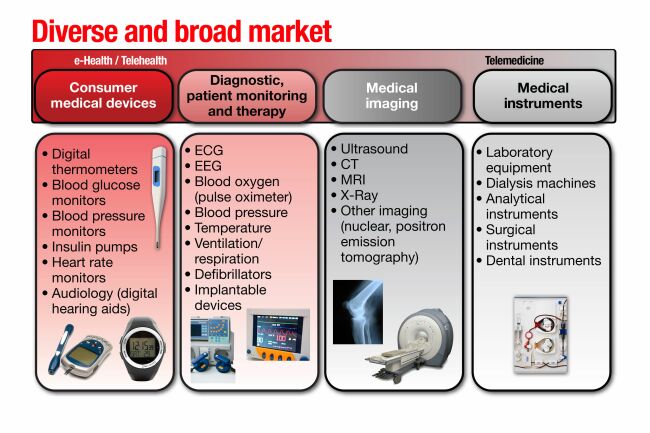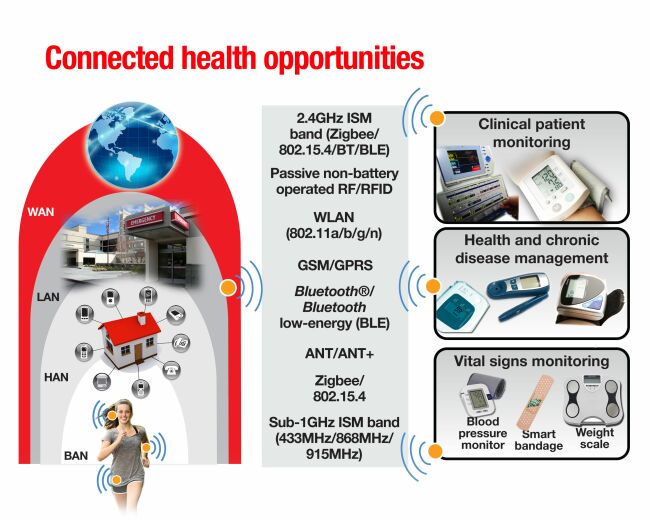Several factors driving mobile healthcare from concept to reality include the growth of the elderly population, the increase in healthcare costs, the demand for telemedicine, and the growing awareness and demand for healthy living and fitness (Figure 1). In the past, the obstacles that prevented this concept from becoming a reality were network connectivity, security, reliability, and low cost and low power consumption. Figure 1: Drivers of healthcare development. A lot of work has been done to use technology to improve the quality and ease of use of medical devices. A key factor affecting wireless medical solutions is to greatly reduce the size of medical equipment, so that mobile health care equipment can be found in clinics, doctors' offices and even the homes of patients (Figure 2). To achieve this, designers must thoroughly understand analog and embedded processing, system knowledge, global support infrastructure architecture, advanced process technology, and the evolution of the medical industry. In addition, they must always meet the high standards of quality and reliability in the medical market. Claim. Figure 2: The impact of wireless technology on healthcare. In recent years, with the widespread adoption of low-power wireless technologies such as Bluetooth Low Energy (BLE) and ANT in smart phones and some single-mode peripherals, an ecosystem that allows doctors and caregivers to wirelessly connect to healthcare monitoring systems It came into being. Although some home health equipment may be mobile (such as activity monitors, etc.), some health equipment is usually fixed in a place in the home (such as weight scales, etc.), and may not be able to connect to the wireless gateway. Because people often move around at home, wearable devices such as watches or jewelry can automatically transmit buffered data from remote scales to a gateway at another place in the home. For most patient monitoring systems, it is very important to ensure data integrity while ensuring mobility and system flexibility. Wi-Fi and Ethernet are the interfaces that allow the hospital to network all its equipment and connect it to the patient's home. After the patient wears the wireless body sensor network device, the nursing staff can remotely connect the patient. This can be achieved by connecting to the patient's home security system, data integration manager, or even a mobile phone using the hospital's internal network or link. These data are transmitted to the nursing staff or call center, so as to realize the continuous monitoring of the personal situation of the patient's family (Figure 3). ConTInua Health Alliance (ConTInua Health Alliance) is a non-profit, open industry alliance composed of the world's leading health care and technology companies to improve personal health, aiming to establish a universal personal remote for promoting patient autonomy Health care solution system. In addition, it also allows people and many organizations to better manage health. The urgent need to obtain certification in the healthcare industry will further increase the use of various general-purpose devices, and the collaborative work of these devices will further improve the healthcare ecosystem. Figure 3: Health care monitoring ecosystem. Interfaces and standards In an effort to establish an interoperable medical device ecosystem, Continua Health Alliance defined various medical devices connected to the data integrator (or manager) through transmission protocols (such as USB, BLE, and Zigbee, etc.) (Figure 4). The alliance uses many existing standards to transmit and receive data between various medical devices. If a medical device manufacturer wants to use the "ConTInua" logo on its products, it must pass a strict certification process. Figure 4: Wireless interface and standards. Communication distance, data rate and power consumption are all key considerations when choosing a certain wireless interface. Both Bluetooth and BLE protocols have a certain communication distance and have a higher data rate than Zigbee. Compared with traditional Bluetooth technology, BLE has a higher efficiency for the sensor, so that a smaller battery size can be used. On the other hand, Zigbee has a medium data rate and duty cycle, and supports mesh networks, allowing multiple sensors to be used in the same system to achieve longer communication distances. Choose the right solution for peripheral devices When selecting wireless technologies and solutions for peripheral products, product designers need to consider a series of issues. Network processors and real single-chip solutions have their own advantages. The advantages of the network processor are: simple interface and easy integration; no need for existing application code ports. The advantages of the single-chip solution are: minimizing costs by reducing BOM components; occupying less board space and optimizing power consumption. When looking for a manufacturer that can provide a complete solution, product designers need to know their needs-do you need a network processor or a single-chip solution? Do you require a fully compatible, integrated BLE stack? Do you need single mode or dual Mode support? Do you require a configuration file, that is, an easy-to-use interface? Do you want to design in the module or directly integrate the chip on the board? Do you need RF design support? Do you require third-party hardware, software, system integration Is it supported? According to product and business needs, product designers can choose different combinations. TI provides a variety of solutions that meet the various needs of many manufacturers, making this process easier. Summary of this article From a technical implementation perspective, the success of mobile healthcare products depends on the availability of many solutions. These solutions enable portability, network access, and data security. It is expected that healthcare monitoring systems will quickly spread from hospitals to ordinary households, which will help doctors and patients monitor trends and events related to patient health. There is no doubt that providing a security infrastructure with various functions for the monitoring system is the key. We make OBD connector with terminal by ourselves,
soldering type and crimping type are both available. Also 12V and 24V
type. OBD1, OB2, J1939, J1708, J1962, etc. Also molded by different
type, straight type or right-angle type. The OBD connector cables used
for Audi, Honda, Toyota, BWM, etc. We have wide range of materials
source , also we can support customers to make a customized one to
replace the original ones. OBD Connectors,Sae J1708 Connector,Sae J1939 Connector,OBD2 Diagnostic Connectors,Diagnostic Connector,Deutsch Diagnostic Connector ETOP WIREHARNESS LIMITED , https://www.etopwireharness.com



June 12, 2020